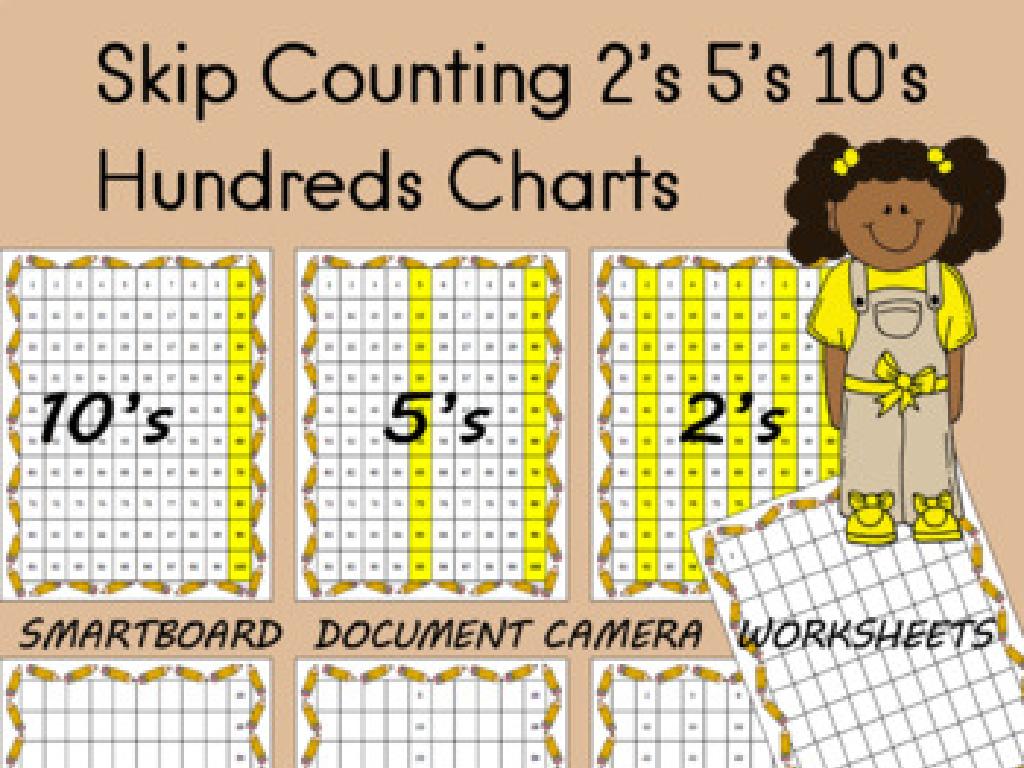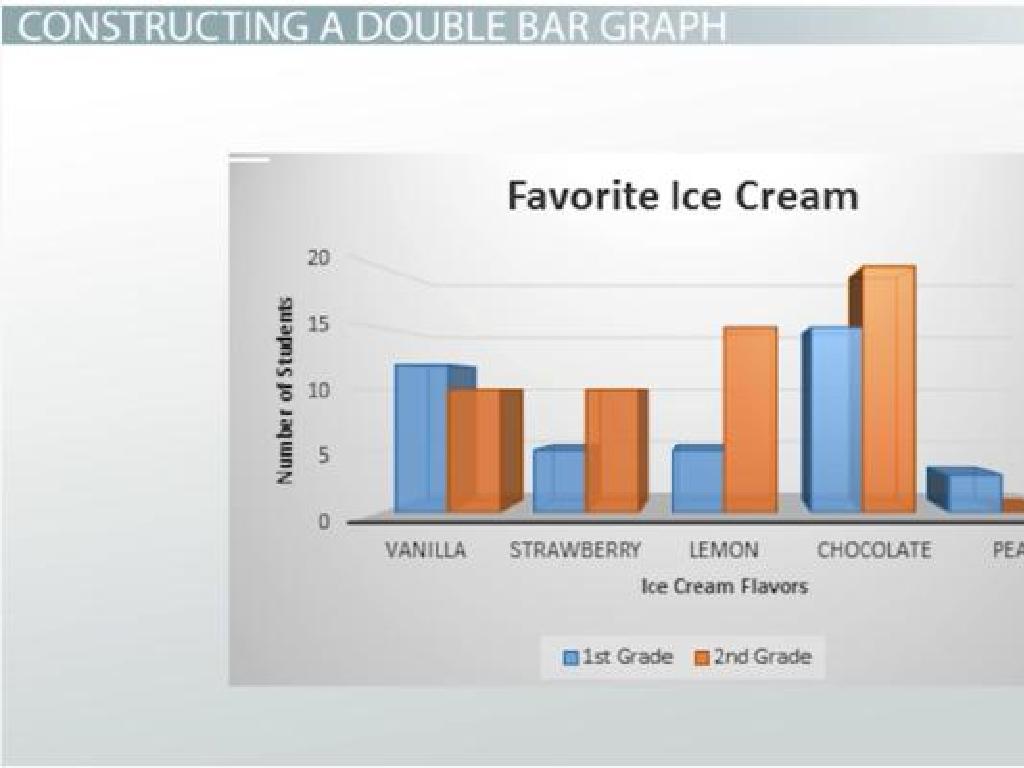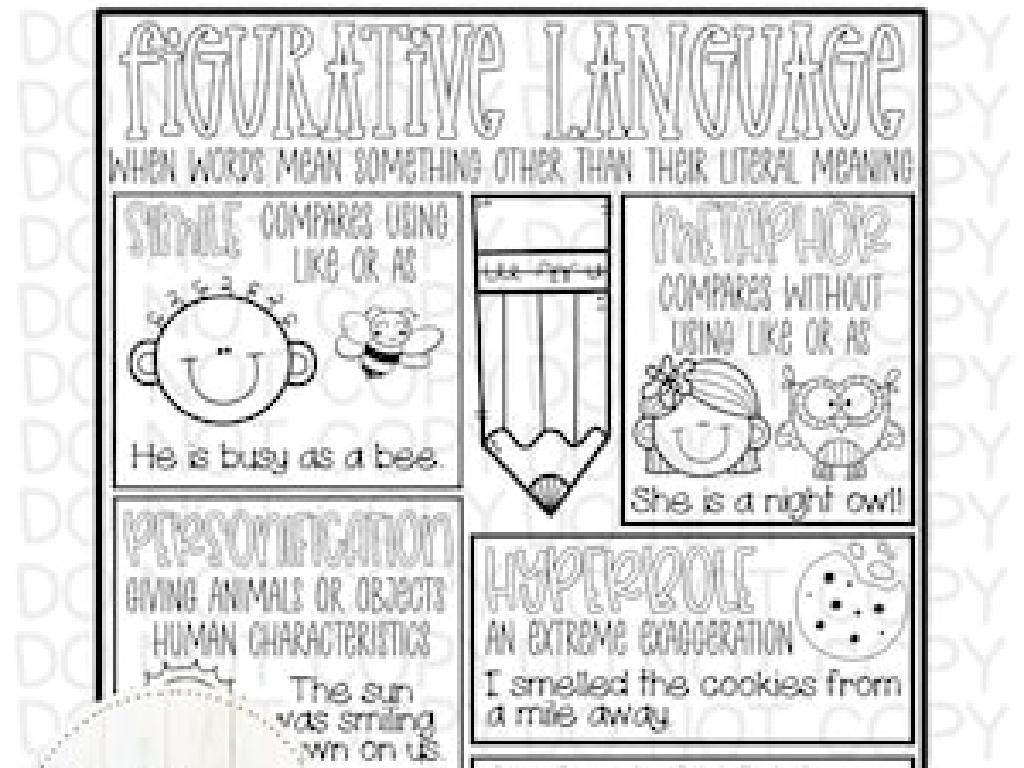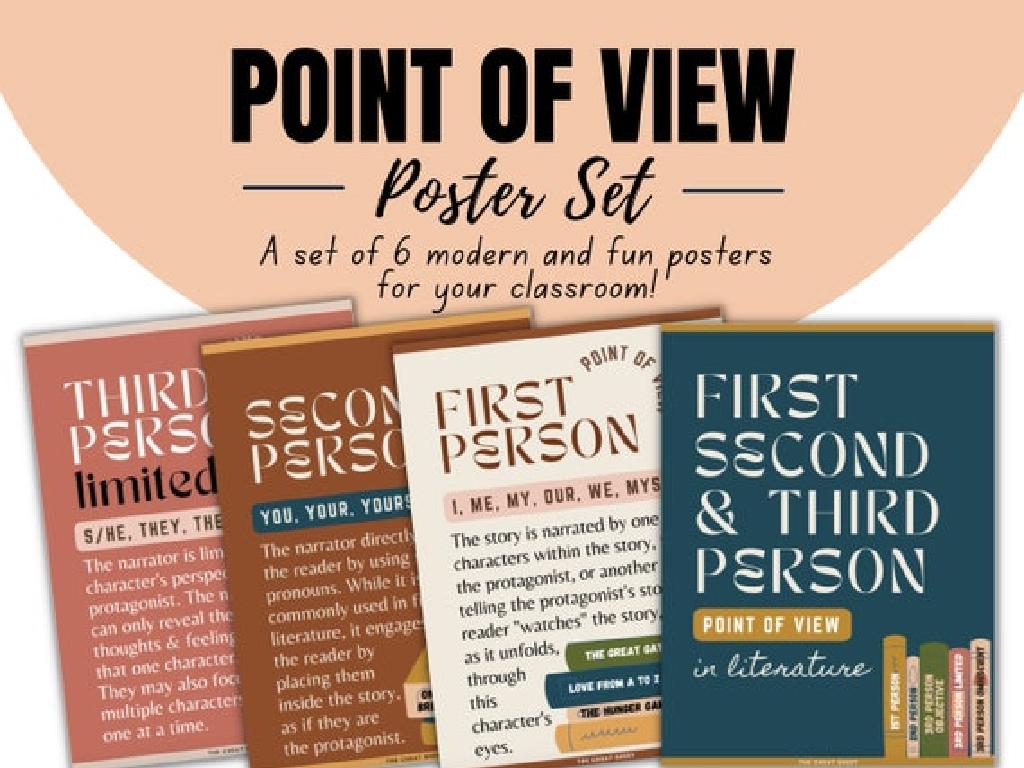Choose The Text That Matches The Writer'S Purpose
Subject: Language arts
Grade: Second grade
Topic: Author'S Purpose
Please LOG IN to download the presentation. Access is available to registered users only.
View More Content
Understanding the Author’s Purpose
– Discover why writers write
– Learn about Author’s Purpose
– Is it to inform, persuade, entertain, or explain?
– Become a detective reader
– Use clues in the text to find the purpose
– Match text to the purpose
– Practice by linking stories to reasons
|
This slide introduces the concept of Author’s Purpose to second-grade students, emphasizing the reasons why writers write. It’s crucial to explain that authors write for various purposes: to inform, persuade, entertain, or explain something to the reader. Encourage the students to become ‘detective readers’ who look for clues in the text to determine the author’s intent. Use examples from familiar stories and texts to illustrate each purpose. In the following activities, students will practice by reading short texts and identifying the author’s purpose, thereby enhancing their comprehension skills and critical thinking.
Understanding Author’s Purpose
– Why do authors write?
– Three main reasons: PIE
– Persuade, Inform, Entertain: key reasons for writing
– Examples of each purpose
– Ads persuade, facts inform, stories entertain
– Identifying the purpose in texts
– Use clues in the text to find the author’s goal
|
This slide introduces the concept of Author’s Purpose to second-grade students. Begin by explaining that authors write with different goals in mind. Introduce the acronym PIE to help them remember the three main purposes: Persuade, Inform, and Entertain. Provide clear examples for each, such as advertisements for persuasion, textbooks for information, and fairy tales for entertainment. Encourage students to think of their favorite books and what purpose they might serve. The activity will involve identifying the author’s purpose in various texts, helping students to recognize the intent behind different types of writing. This foundational understanding will enhance their reading comprehension skills.
Understanding Persuasive Texts
– What is persuasive writing?
– It’s writing that tries to get you to agree
– Persuasive writing aims to convince
– The author shares their viewpoint strongly
– Examples: Ads, speeches, opinions
– Think about commercials or a class president’s speech
– Recognizing persuasive language
|
This slide introduces the concept of persuasive writing, which is used by authors to convince readers to adopt a particular viewpoint or take action. Explain that persuasive writing can be found in various forms, such as advertisements that try to get us to buy something, speeches that aim to persuade us on certain topics, or opinion articles where the writer expresses their thoughts on an issue. Discuss with students how to identify persuasive language by looking for words that make us feel strongly or try to influence our thoughts. Encourage them to think of times when they have been persuaded by someone’s words and to share examples from their own experiences.
Understanding the Author’s Purpose: To Inform
– What is informative writing?
– It’s writing that teaches us new things
– Informative writing gives facts
– It doesn’t tell a story, it teaches
– Examples: Textbooks, News, Manuals
– Textbooks for learning, news for updates, manuals for instructions
– Recognizing informative texts
|
This slide introduces students to the concept of informative writing, which is one of the key purposes of an author’s writing. Informative writing aims to provide the reader with facts, knowledge, and information without the intention of persuading or entertaining. Use examples like textbooks for learning subjects, news articles for current events, and instruction manuals for using devices to illustrate informative texts. Encourage students to think about how these texts are different from stories or advertisements. In the next class, we can have an activity where students bring in examples of informative writing and explain what they learned from them.
Understanding the Author’s Purpose: To Entertain
– What does ‘to entertain’ mean?
– ‘To entertain’ means the writing should be fun to read
– Entertaining texts make us happy
– Examples: Novels, Comics, Poems
– Stories with exciting adventures, funny comics, or beautiful poems
– Choose a text that makes you smile
– Think of a book or story that made you laugh or feel excited
|
This slide aims to help students recognize when an author’s purpose is to entertain. Begin by explaining that some writing is meant to make us feel good, like when we listen to a funny story or read an exciting adventure. Provide examples of entertaining texts such as novels that take us on adventures, comics that make us laugh, and poems that paint pictures in our minds. Encourage students to think about what they like to read for fun and to understand that the author’s goal is to provide enjoyment. Ask them to bring in their favorite entertaining book or comic to discuss how it fits the purpose ‘to entertain’. This will help them connect the concept to their personal experiences.
Matching Game: Author’s Purpose
– Understand author’s purpose
– Why did the author write this?
– Match text to the purpose
– Is the text to inform, persuade, entertain, or explain?
– Explain your choice
– Use clues in the text to decide the purpose
– Have fun learning!
|
This interactive game is designed to help students grasp the concept of author’s purpose in a fun and engaging way. Present various texts to the class and ask the students to determine whether the author’s intent was to inform, persuade, entertain, or explain. Encourage them to use context clues and the content of the text to make their decisions. For example, a text with facts about turtles might be to inform, while a story about a funny turtle could be to entertain. Provide immediate feedback to reinforce learning. This activity will not only help students with comprehension but also with critical thinking as they justify their answers.
Understanding the Author’s Purpose
– Read a text as a class
– Think about the author’s goal
– What is the author trying to do with this text?
– Is it to Persuade, Inform, or Entertain?
– Persuade means to convince us, Inform means to teach us, and Entertain means to make us enjoy.
– Discuss our ideas together
|
This slide is aimed at helping students understand the concept of the author’s purpose in writing. Start by reading a selected text together as a class. After reading, engage the students in a discussion to determine whether the author’s intent is to persuade the reader of a particular viewpoint, to inform the reader with facts and information, or to entertain the reader with a story or humorous text. Encourage students to provide evidence from the text to support their opinions. This activity will help students to critically analyze texts and understand that writing is done with specific intentions.
Understanding the Author’s Purpose
– Read the text as a class
– Think: Persuade, Inform, or Entertain?
– Is the author convincing us, teaching us, or making us smile?
– Discuss the author’s goal
– Talk about why the author wrote the text
– Share examples from the text
– Pick parts of the text that show the purpose
|
This slide is aimed at helping students understand the concept of the author’s purpose in writing. Begin by reading a selected text together as a class to ensure all students are familiar with the content. Prompt students to think critically about whether the author’s intent is to persuade the reader of a particular viewpoint, to inform them with facts and information, or to entertain with a story or humor. Facilitate a class discussion where students can express their thoughts on the author’s purpose and encourage them to provide specific examples from the text to support their opinions. This activity will enhance their analytical skills and their ability to discern the intent behind various texts.
Understanding the Author’s Purpose
– Read the text as a class
– Think about the author’s goal
– What is the author trying to do with the text?
– Is it to Persuade, Inform, or Entertain?
– Persuade means to convince, Inform means to teach, Entertain means to make us enjoy
– Discuss our ideas together
|
This slide is aimed at helping students understand the concept of the author’s purpose in writing. Begin by reading a selected text together as a class to ensure all students are familiar with the content. Then, guide the students to think critically about what the author’s intention might be. Is the author trying to persuade the reader to do or believe something? Are they providing facts and information, or are they trying to tell a story that is enjoyable? Encourage students to use clues from the text to support their ideas. Facilitate a discussion where students can share their thoughts and learn from each other’s perspectives. This activity will enhance their critical thinking and comprehension skills.
Class Activity: Be the Author!
– Decide on your writing purpose
– Write your own short paragraph
– Think about what you want to tell your friends
– Share with your classmates
– Read your story to the class with excitement
– Guess the purpose of others’ stories
– Listen carefully and think: Why did they write this?
|
In this activity, students will apply their understanding of an author’s purpose by creating their own piece of writing. Teachers should guide students to choose a purpose (to inform, to entertain, or to persuade) and then write a short paragraph aligned with that purpose. After writing, students will share their paragraphs with the class. The rest of the class will guess the author’s purpose, providing an interactive way to reinforce the lesson. Possible activities: 1) Writing a short story for entertainment, 2) Describing their favorite animal to inform, 3) Writing a letter to persuade the class to read a book, 4) Creating a make-believe recipe with silly instructions. This exercise will enhance students’ comprehension of the different reasons for writing and how to convey them effectively.
Review and Reflect: Author’s Purpose
– Recap on Author’s Purpose
– Authors write to Persuade, Inform, Entertain, or Explain.
– Understanding the ‘why’ behind texts
– Knowing the purpose helps us get the message.
– Texts with multiple purposes
– Yes, like a funny advertisement that also sells a product.
– Applying our knowledge
|
Today’s lesson focused on understanding the Author’s Purpose. We discussed how authors might write to persuade, inform, entertain, or explain something to their readers. Understanding the author’s purpose is crucial as it helps us to better grasp the message and intent behind a text. We also explored the idea that texts can often serve more than one purpose, such as a comedic advertisement that both entertains and persuades. To apply our knowledge, consider having students bring in examples of texts with a clear purpose and discuss as a class. Additionally, students can create their own sentences or short paragraphs with a specific purpose in mind.
Becoming Author’s Purpose Detectives
– Congratulations, purpose detectives!
– Understanding the Author’s Purpose
– Authors write to Persuade, Inform, Entertain, or Explain (PIEE).
– Keep practicing your detective skills
– Look for clues in texts to determine the purpose.
– Enjoy reading and discovering!
|
This slide is meant to wrap up the lesson on Author’s Purpose. Congratulate the students on their hard work and remind them of the importance of understanding why an author writes a text. Reinforce the concept of PIEE (Persuade, Inform, Entertain, Explain) and encourage them to continue practicing by looking for clues in every text they read. This will help them become more critical readers. As they read at home or in school, they should try to identify the author’s purpose and discuss it with peers or family members to reinforce their learning.





